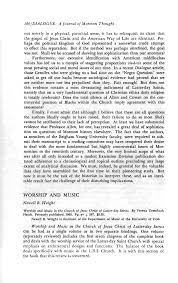Articles/Essays – Volume 04, No. 1
Worship and Architecture | Verena Ursenbach Hatch, Worship in the Church of Jesus Christ of Latter-day Saints
The irreverence in the Church today “is not irreverence of disdain for spiritual things, but rather the irreverence of undeveloped spirituality.” So writes the author of Worship in the Church of Jesus Christ of Latter-day Saints. “Worship, the realization of communion with God, continues to be the greatest comfort available to mortal man,” stated President David O. McKay in 1963. The attainment of this goal in the Church has prompted the author to compile ideas and scriptural references which take the reader through an outline of analytical thoughts.
The book, written to “share findings with others,” is presented in a direct though unimaginative way, with the definition and purpose of worship followed by a more detailed discussion of a method of attainment. The book recognizes candidly that in the Church “1) assembly worship is not as successful as it should be, 2) reverence in worship services is a direct result of worship experience; order or discipline is a pre-requisite, and 3) true worship is realized through an understanding of the nature and purpose of worship, through skillful planning and conducting of services and through enlightened participation of the congregation.”
A significant portion of the book is devoted to the relationship of the architectural environment to effective worship, with chapters on theological architecture and the Latter-day Saint chapel. Since the Lord has always re quired his children to build places of worship, the author (with assistance from her husband, an architectural programmer at BYU) has, as a layman, discussed briefly and at minimum depth the recognition that environment has a real effect upon the beholder, and that that influence must be either positive or negative in character. This influence—physical, emotional, or spiritual—can and should be positive. The book includes a brief history of theological architectural developments which give the lay reader a casual understanding of architectural responses to methods of worship. It then discusses the construction of L.D.S. chapels designed for the real purpose—worship. These suggestions, while potentially interesting to Church members, will not likely promote a change in present Church construction policies which seem to guarantee mediocre, if not totally unsuccessful, solutions to facilities required for meaningful worship. “Square foot” programs with allowances for circulation handed to an architect by a programmer, as suggested by the author, may result in a “well thought out plan,” but will not result in a space contributing to satisfying worship.
The book’s unpretentious presentation is not likely to. interest the casual reader, nor would it incite a deep personal commitment to the attainment of more perfect worship in the Church. But it could serve as a legitimate guide to the individual needing “lesson manual” assistance in understanding the essence of worship.
Worship in the Church of Jesus Christ of Latter-day Saints. By Verena Ursenbach Hatch. Privately published, 1968. Pp xiv + 119. $3.95.


 Back to full Issue
Back to full Issue

